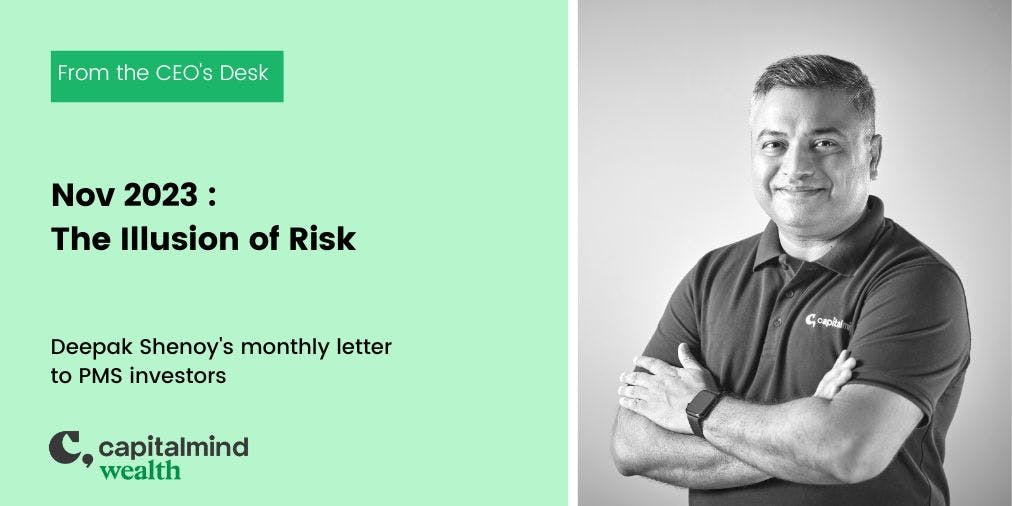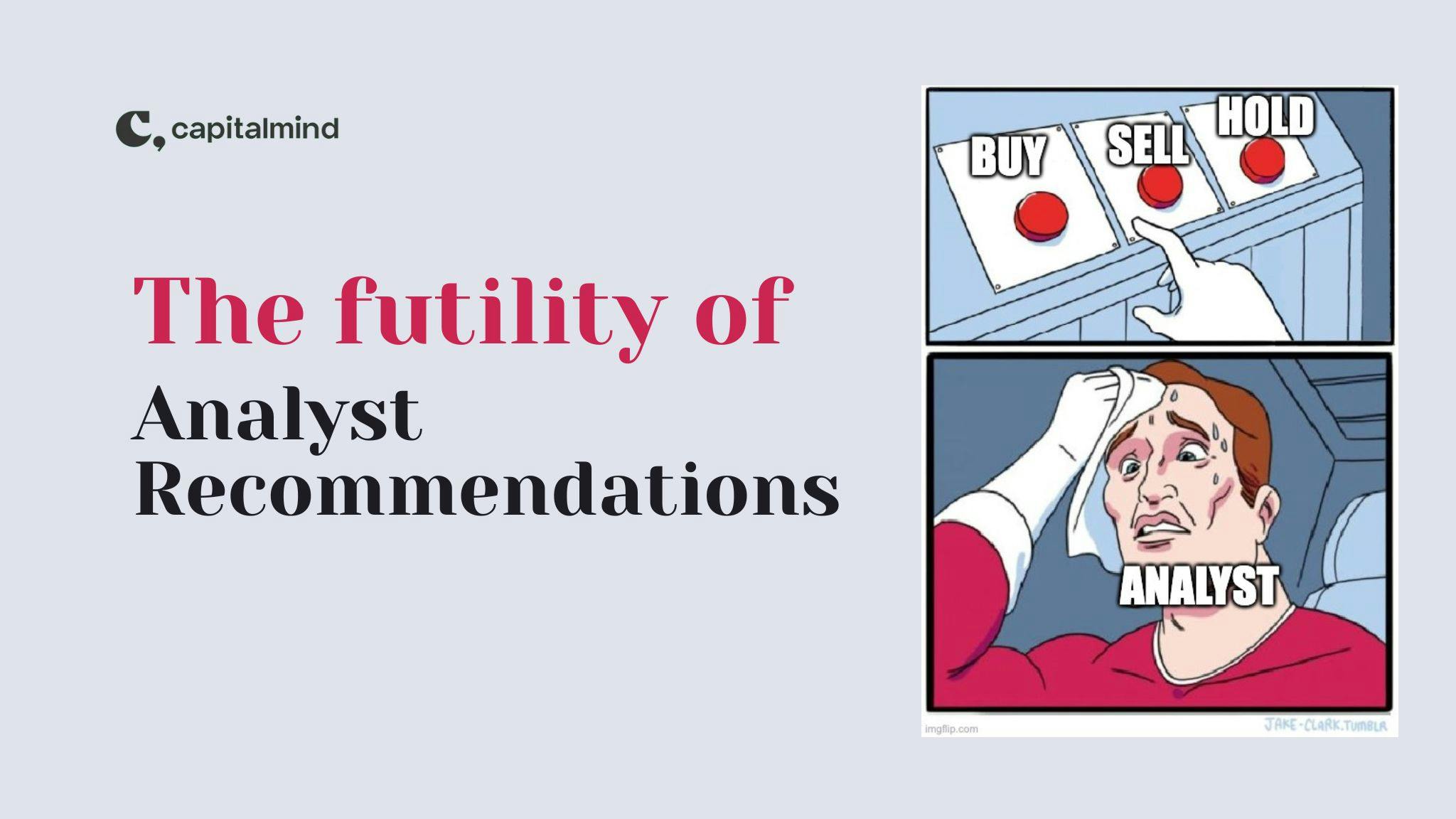(category)Deepak's Memos
Wealth Letter Nov 2023: The Illusion of RiskWealth Letter Nov 2023: The Illusion of Risk
Deepak Shenoy•

Such a stark difference from April this year, when the world markets saw jitters after the collapse of Silicon Valley Bank, FIIs had sold over 125,000 cr. in a year, people were fearful, markets were uncertain, inflation in the US was ticking up, US interest rates were high and so on.
Just six months later, people are still fearful and uncertain, interest rates worldwide are high and somehow, we're at 6% more on the Nifty and 15% higher or more in our portfolios. It's remarkable how much times change and how much they are still the same.
Risk: Find out what will kill you and then back it off a little bit?
Jerry Seinfeld, the stand-up comic more famous for the TV series with his name, had a show in which he spoke about over the counter medicines:
"Then they tell you about the pain relieving ingredient. There’s always gotta be a lotta that. Nobody wants anything less than ‘extra-strength’. ‘Extra-strength’ is the absolute minimum. You can’t even get ‘strength’. ‘Strength’ is out now. It’s all ‘extra-strength’. Some people are not satisfied with ‘extra’; they want ‘maximum’. Give me the ‘maximum-strength’. Give me the maximum allowable human dosage. Figure out what will kill me and then back it off a little bit.”
Now that might be funny, but in reality a lot of our financial thoughts happen to be that way. In times when the markets are booming, this is how you would expect your portfolio to behave. Maximum strength. Maximum possible dosage. Except the last part, which is important - "back it off a little bit" - doesn't always happen. People go gung-ho on options, find something that gives them 10% a day, and then it takes away 100%. When you lose 100%, you have nothing the next day. You're the financial equivalent of medically dead.
In the trial of Sam Bankman Fried (SBF) - the man behind the mega-fraud crypto exchange FTX and Alameda fund - his ex-girlfriend, Caroline Ellison (also the CFO of Alameda) was asked about how SBF thought about risk. She explained it this way: If you gave him a coin and said that if it lands on heads the world will be doubly as good, and if it was tails, the world would be destroyed, he would take that bet.
When SBF was asked the same thing, he said he'd take the bet again and again. Someone asked him that look, you could just land on tails even once and the world would be destroyed! And he replied, but if it didn't, think of how much better it would be.
This is incredible, not because of the reward, but because of the downside. The idea, in investing is to not die. I've mentioned Larry Hite's statements in earlier letters but for the benefit of the new readers:
If you don't bet, you can't win
If you lose all your chips, you can't bet.
And then, there was Warren Buffet, who once said, famously: If you give me a gun with five empty cells and a bullet, there is no amount of money that you can promise which will make me pull the trigger. The downside is way too much higher than the upside.
Who takes these mad risks?
There are still people who take mad risks. Usually, they see this as the only way out of their situation, and many times, find some success. It is then folklore; he bet all his capital on Titan, which went up 5000 times. For a certain individual, this wasn't even true, because he had other sources of trading income and capital that would have left him just fine even if Titan hadn't worked out. But why let facts ruin a great story?
The idea of investing risk is to remove the risk of ruin.
My point is simple: don't lose all your money. That is true risk. This doesn't translate very well, though. People think of this as: don't lose any money. That is the "wait a minute, hang on" moment, because if you don't lose any money, you won't make much money. In fact if someone tells you that something is risk free and gives great returns, I will tell you this: you will lose all of your money.
We've seen it before. The NSEL (National Spot Exchange Limited) crisis had 13,500 crores of money invested in what people thought was a high return but low risk game. It worked for two years until...it didn't. Because you were getting conned, by the other side, who was playing a ponzi game. Nearly all low risk, high return games end up being a scam, eventually, or just stop existing.
Consider even Enron. The company sounded like an awesome machine that generated money, simply because they would acquire power projects and then sell them for the present value of the future cash flow (translation: largely from imagination) to some entity which they largely owned themselves but could hide from balance sheets. What seemed like a cash machine was, in effect, a fraud of gargantuan proportions. Risk is often in what you don't see, when it's cloaked in what looks super exciting to see.
How can you take a "little" risk?
Risk is often considered an on-off thing, but we all know it's not. We take calculated risks in everything, including crossing the street, or not wearing masks. In investing, everything has a layer of risk. If the point is not lose all (or most) of your money, then the simple way to avoid it is:
- Diversify: Any single investment that "fails" shouldn't destroy your portfolio. So have enough positions that are in different industries, so any single one isn't the achilles heel in your portfolio. Even the good folks that say "diversification is for the ignorant", end up having hundreds of stocks in their portfolio, so it's better to watch what they do rather than what they say. This will mean you will have some winners and some losers, by the nature of the game, so:
- Water the flowers, cut off the weeds: Exiting when a stock is doing well is a bad idea, usually. You have to stick with an investment that is performing well in terms of being aligned with your strategy. And to slowly reduce or remove what isn't. This simply means one thing: make more money from each winner, on average, by letting it run compared to how much you lose on stocks that didn't do well.
The "heroes" can easily be people who bet their fortune on one stock (who cares to diversify?) and then they tell you that they booked profits at every 10% rise in that stock. It's a sure-fire way to look good, but just as sure-fire to not have the good reflect in the bank balance. Because they book profits on the ones going up, but they let the losses fester and eventually you come out not quite making the cut.
The second part is often less understood. Focusing on the number of stocks that are winners ("70% of my stocks made money") is not anywhere close to useful, but we are programmed to think that way, even at very highly erudite levels. It isn't the ratio of stocks that you win on. It's much more about making big wins and small losses. Over a long term, the win-loss ratio is not relevant. It's that you win more when you win, because you let your winners run and make you large returns. Think about it - the maximum you can lose in any single investment is 100%, but you can make 500% in a stock on the upside. The natural skew means that it's more important to let your portfolio realize the winners by not exiting them when they "only" double, which is 100% return, for example.
Risk is also not about probabilities.
Consider the three forms of risk investors:
- Junk bond fixed income types: You expect to win 98% of the time, making say 10% to 12%. But 1% of the time you will lose 100% of what was invested. So if you invest Rs. 1 each in 100 such investments, you might win on 98 of them (making Rs. 9.8 in profit at 10%) but lose on two (losing Rs. 2). Net earning: Rs. 7.8. On Rs. 100, this is a 7.8% return, which is not great but still positive.
- Extreme opposite: the Venture Capitalist. Invests in 20 companies, in which only 2 will succeed. But each of the 2 must give him a 20x return. So even if the remaining 18 go to zero, the result is he doubles his money. (Rs. 18 goes to zero, Rs. 2 becomes Rs. 40, out of Rs. 20 invested)
- Everything else in the middle, such as stock market investors. If you win 55% of the time, double your money when you win and lose 50% when you lose, a Rs. 100 divided between 100 companies will see you make Rs. 132.5.
All these have different probabilities of winning, and yet make their money as a whole.
Importantly also, the risk is managed better by letting your winners ride. The VC economics fails if he exits at a 200% returns - he needs the 20x!
Finally, let's also be cognizant of the fact that probabilities can only work if your sample size is large. A coin flipped 2 times has the same chance of hitting two consecutive heads or tails, as it does of hitting one head and one tail. You need to flip it many many times for the overall result set to be close to 50% each. In investing, that means when you speak of probabilities, make sure you are taking enough bets. Otherwise, like the great Yogi Berra said, in theory there is no difference between theory and practice. In practice, there is.
At Capitalmind, our quantitative approaches go through the process of:
- Test on as much data as is reliable (in India, that's a painfully restricted data set, similar to usable roads in Bangalore)
- Understand how systems would have worked without the benefit of hindsight (if a company went bankrupt, include it in the past data, as you might have selected it)
- Be aware that win percentages, outperformance ratios etc need enough "instances" for the probabilities to actually be trustworthy.
- Understand Yogi Berra's "in practice, there is", so expect things to behave differently from the theory.
We can't claim that we will always do well. We can't claim to know what will come. All we know is: bad things happen more often than we expect, and the more situations we can test our strategies on, the more confidence we get.
Risk, beyond a point, is also knowing that you don't know everything, and keeping yourself agile. The often reviled statement is to have strong opinions, held weakly. Change an opinion if you must. Don't be chained by what you said or did, because times will change. The risk is in not changing at all. I'll quote Chesterton, as I have before: Angels can fly because they take themselves lightly.
So, as we come to the end of this letter (phew, I hear you say), we also wish you and your loved ones a prosperous, joyous Deepavali! (If you're sufficiently North of the Vindhyas, Happy Diwali!) Enjoy the festivities and we will continue to be vigilant and watchful of the portfolios we manage for you.
De-riskingly,
Deepak
Note: this was sent to customers in Nov 2023, and is being published a little while later. Check out the Capitalmind Wealth PMS if you aren't already there!
Related Posts
Make your money work as hard as you do.
Talk to a Capitalmind Client AdvisorInvesting is not one size fits all
Learn more about our distinct investment strategies and how they fit into your portfolio.
Learn more about our portfoliosUnlock your wealth potential
Start your journey today




